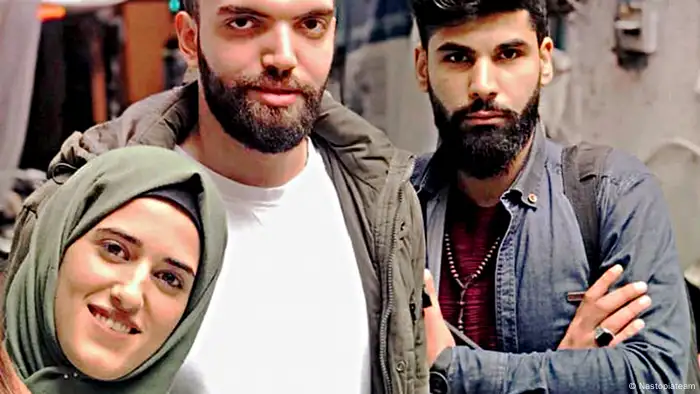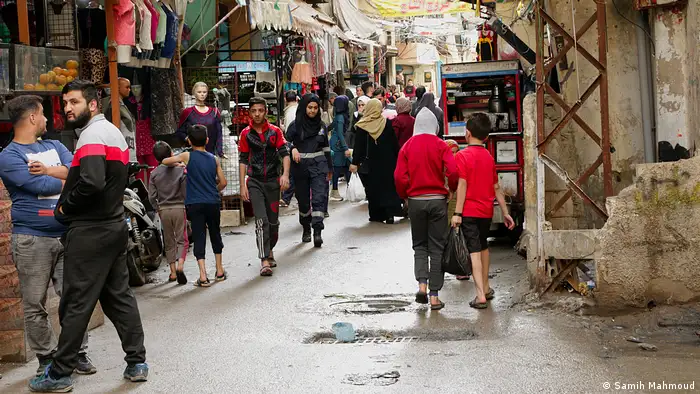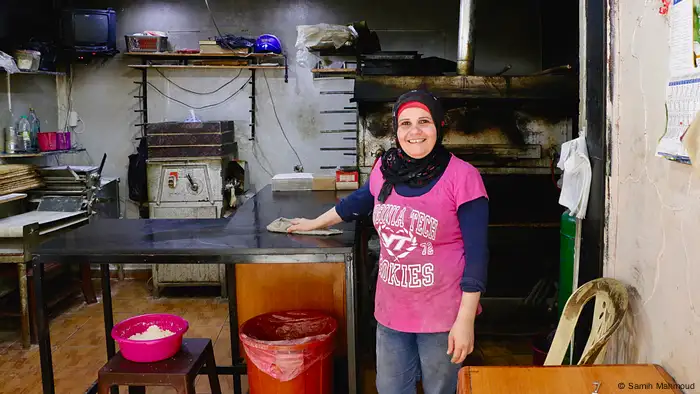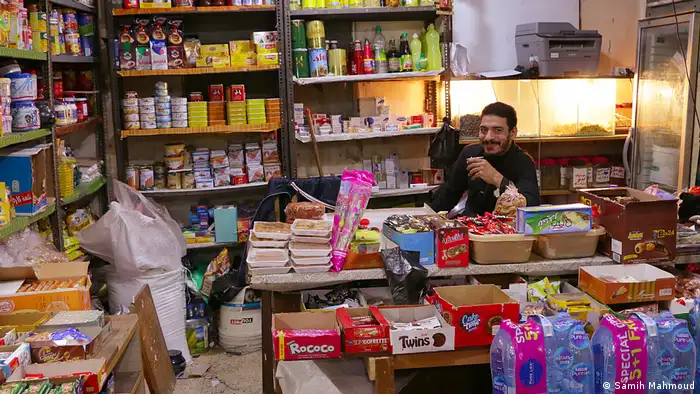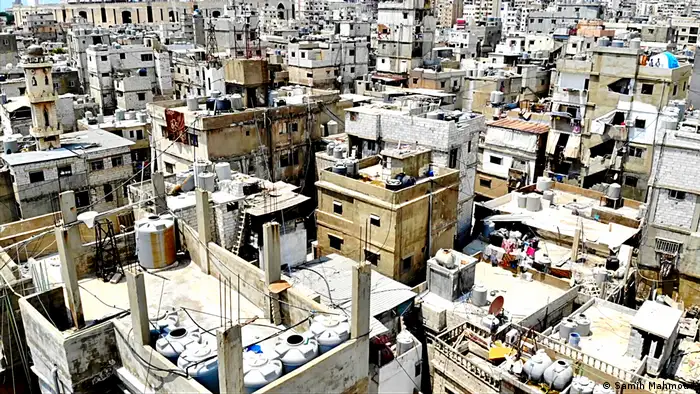Our impact
Knowing what really is going on - How media projects are changing the daily life of refugee camps
Vibrant media scenes are developing in refugee camps in Lebanon as young citizen journalists produce video reports to be published on social media.
Down a narrow alley in the Shatila refugee camp south of the Lebanese capital Beirut, women are walking with fully loaded shopping bags as moped drivers ride past them. A poster of Yasser Arafat hangs above a power box beside other Arab leaders. Fruits, vegetables, and household goods are spread out in front of shops. Samih Mahmoud lives with his family in this alleyway. The 22-year-old had to flee Syria six years ago and now calls the camp home.
Samih is on his way to an interview. He works as a citizen journalist for Campji, a media initiative founded in 2016 by the DW Akademie and the then partner organization Basmeh & Zeitooneh. Reports by Campji journalists are published on Facebook, Instagram, and YouTube. Campji is one of the first independent, digital media outlets in which refugees report for refugees. It’s on Campji that they have a say on their everyday issues as well as their their fears, successes, desires, and dreams.
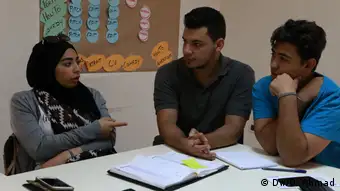
Rayyan, Samih and Omar from Campji, one of the first independent media outlets for and with refugees.
Like all citizen journalists working for Campji, Samih learned how to do research, conduct interviews, produce reports with a mobile phone, and take professional photos. His reports are now almost like those done by a professional. Samih has a photo session with Um Bakr scheduled today. The 46-year-old runs a bakery and produces manaqisch, popular round flat cakes with a cheese or thyme mixture. Shortly after Campji was founded, the outlet did a portrait of the energetic woman. She was one of the first interviewees from Shatila to speak frankly about her life in front of a camera.
"These These young reporters ask uncomfortable questions. They look at where it hurts and what people cannot normally talk about here such as corruption or drugs," said Bakr. "To know what's really going on in our camp, I follow Campji."
Samih walks down a few streets to meet Mohammad Hassan who operates a supermarket. The 36-year-old barely watches television anymore.
"I just cannot stand the news anymore. Everything is so negative. It gives me a headache," said Hassan who now gets most of his news through social media. "I can choose what I want to see whether its entertainment, social, or religious topics. Social media in our camp have made people more open in their opinions."
Media by, about, and for refugees
The Shatila refugee camp is one of the poorest districts in Beirut. Its inhabitants live in a very small area with no functioning sewage system, water, or electricity supply. Unemployment in the camp remains very high. Palestinians who were forced leave their homeland when Israel was founded in 1948 live here along with their descendants. The remainder of the population is made up of impoverished people from Lebanon, refugees from Syria, and low-income earners from other countries. The exact population of the camp is unknown but estimates put the number at 30,000.
An independent media organization like Campji was unthinkable in Shatila and the 12 other refugee camps in Lebanon until a few years ago. In the past, almost all of the media was in the hands of the various Palestinian political groups that controlled who was allowed to speak publicly. The camps are managed by committees representing the various Palestinian political groups, such as the PLO and Hamas.
Over the past decade, the media landscape in the Palestinian camps has changed dramatically. The political developments in Lebanon, which pushed back against the influence of the political groups, has played a decisive role. According to Ahmad Laila, the Internet is also leading the change. The Palestinian journalist lives and works in Beirut but grew up in a camp in northern Lebanon. He has observed how people are now discussing and exchanging messages in online forums. Mobile messenger apps and social media are now very popular in the camps for quickly getting news on current developments. But what was lacking was professionally-told stories about the people in the camps.
"I think the know-how was not there like how to deal with technology, storytelling, and topic selection," said Laila. "That came with Campji. This media initiative has brought something new to the scene."
Campji has been a pioneer for media in the camps because its content is produced by and for refugees and this format is now helping to revitalize local media scenes. Since Campji was founded, at least eight other similar media projects have since sprung up, all reporting on everyday topics in the camps and providing people with relevant news and information.
No fear in front of the camera
Just down the road from Shatila lies the Burj al-Barajneh refugee camp. An estimated 20,000 people live in the camp including Lilyan Samrawi (22), Raafat Falah (24), and Nassar Tanji (23). Just like Samih, these three are budding citizen journalists. They report for a project called Nastopia, a combination of the words "Nas," which means "people" in Arabic, and "utopia." Nastopia has been publishing content on Facebook since 2018. Like Campji, they report about everyday issues in the camp and deliver pertinent information to its inhabitants.
The young journalists are sitting in their regular café. Colorful cans of fruit juices and soft drinks are scattered across the table. Raafat smokes from a hookah as noise from the busy street filters in through the large windows. The trio often comes here to discuss their work.
"This is like our second home," said Lilyan.
The café is located on a busy two-lane road a few steps from Burj al-Barajneh. Nearby is Nastopia's office which is sparsely furnished with black desks and a black imitation leather sofa.
When they're not in the office or the cafe, the reporters can be found walking the streets of the camp. The owner of a barber shop interrupts his work and steps out onto the street. He recognizes the young citizen journalists. The barber spends a lot of time on social media and loves the funny videos that Nastopia publishes, such as a satirical video about how power cables dangle loosely over streets and sidewalks like tangled balls of wool. A few shops down, the owner of a sporting goods store said that while he mostly follows international, regional Arab and Palestinian broadcasters, for local coverage from Burj al-Barajneh, he uses Nastopia on his mobile phone.
"I think the Facebook page is good because the young people are part of us," he said. "They speak our language. We trust them."
For Nassar, being recognized for their work has meant that people have gradually lost their distrust of the camera.
"For a long time, the residents here only knew Palestinian and Lebanese TV channels that either film poverty or report on violence in the camps," he said.
The young Nastopia journalists have set themselves apart by conducting street surveys, reporting on problems such as the supply of electricity and water and covering positive topics such as the career of a young musician from the camp or an initiative that wants to "green" the roofs of houses. That people should be taken seriously and can talk not just about the dark side of life in the camp, but also about their successes, their happiness, their dreams is new to them.
"Everyone knows us because we always walk around with a microphone and a camera," said Lilyan. The residents have since become accustomed to seeing a woman interviewing people and filming in public.
"Many call us simply 'Nastopia,'" she added.
Raafat and Nassar love working with the camera and the close contact with people it allows. For Lilyan, who is also studying journalism, Nastopia offers her the chance to do real reporting while learning about the lives of her neighbors in the camps.
Human rights through social media
Since people started getting their news information on the Internet or through social media and having dialogues in forums, it is no longer so easy for Palestinian factions to control public opinion. But that does not stop them from trying. Arguing that security in the camps must be ensured, citizen journalists who report in the camp are encouraged to speak to the political groups and ask for permission.
"All journalists need a permit in the beginning but after we know them, we let them do their jobs," said Colonel Ahmad Audeh, one of Shatila security officers. "The Campji reporters abide by the rules. They communicate regularly with the political groups and try to maintain a relaxed relationship, without being talked into which topics they cover."
In the Campji editorial office, Samih and two other journalists, Rayyan, and Omar, also in their early 20s, are meeting to discuss how the platform has changed their lives. They have worked to open up new freedoms in their camp and these efforts have allowed them to discover their place in society. They now have a profession that they love and from which they can live. They are proud of the reports they produce.
Even with all the achievements, citizen media in Lebanese refugee camps is still in its infancy. Despite that, the Campji team has to compete with other initiatives as it continues its plan for further growth. The organization Al-Jana has been overseeing Campji since November 2018.
The head of Al-Jana, Hicham Kayed, has brought in a number of new employees from different parts of the country so that Campji can report from all 12 refugee camps in Lebanon. He also wants to support other media initiatives in the future through workshops or through renting out technical equipment such as cameras or microphones. Instead of viewing them as competitors, Campji is looking to develop into a consultative body that can help newcomers in the market find their niche. The goal is to provide news and information to as many refugees in the Lebanese camps as possible. This would ensure that everyone knows what is happening in the camps so that people can be engaged to work for change.
Meanwhile, reporters Samih, Rayyan and Omar are working on new, innovative formats. They are planning interviews with famous Lebanese-based artists, talks with the first generation of Palestinian refugees who fled there in 1948, and an investigation into why some Palestinians in Lebanon do not have ID cards. In Lebanese refugee camps there is definitely no shortage of topics to report on.
The author: Mona Naggar knows the Middle East through her many years working there as a journalist. As a project manager and trainer for DW Akademie in Beirut, she has a front row seat to media development in Lebanon.
Profile: Lebanon
Who?
- Campji is a media platform by and for refugees in Lebanon.
How does the project work?
- Since 2016, refugees in Lebanese refugee camps have been trained to become citizen journalists and accompanied in setting up their own media platform called Campji.
- Participants are trained in the basics of journalism, mobile reporting, storytelling, and photography.
What are the difficulties?
- Propaganda by Lebanese politicians and government officials against Syrian refugees has created a climate of fear. Refugees are therefore less open to tell their stories in front of the camera.
What has the media project achieved?
- Campji is one of the first independent, digital media platforms where refugees work as journalists and let other refugees have their say on everyday topics.
- Refugees set their own topics and design their own media formats. They make themselves heard in the media and provide their fellow refugees with relevant information.
- Since Campji was founded in 2016, the media landscape has become more diverse. More digital media offerings have been created in the camps.
What are the highlights?
- The Campji Facebook page has been online since November 2016 and now has over 57,000 followers.
- Young people have become citizen journalists and role models for other young people inside and outside the camps. Four of the citizen journalists have received an employment contract from the Al Jana organisation.
WWW links
- Date 13.03.2020
- Feedback: Send us your feedback.
- Print Print this page
- Permalink https://p.dw.com/p/3Y90E
- Date 13.03.2020
- Send us your feedback.
- Print Print this page
- Permalink https://p.dw.com/p/3Y90E

